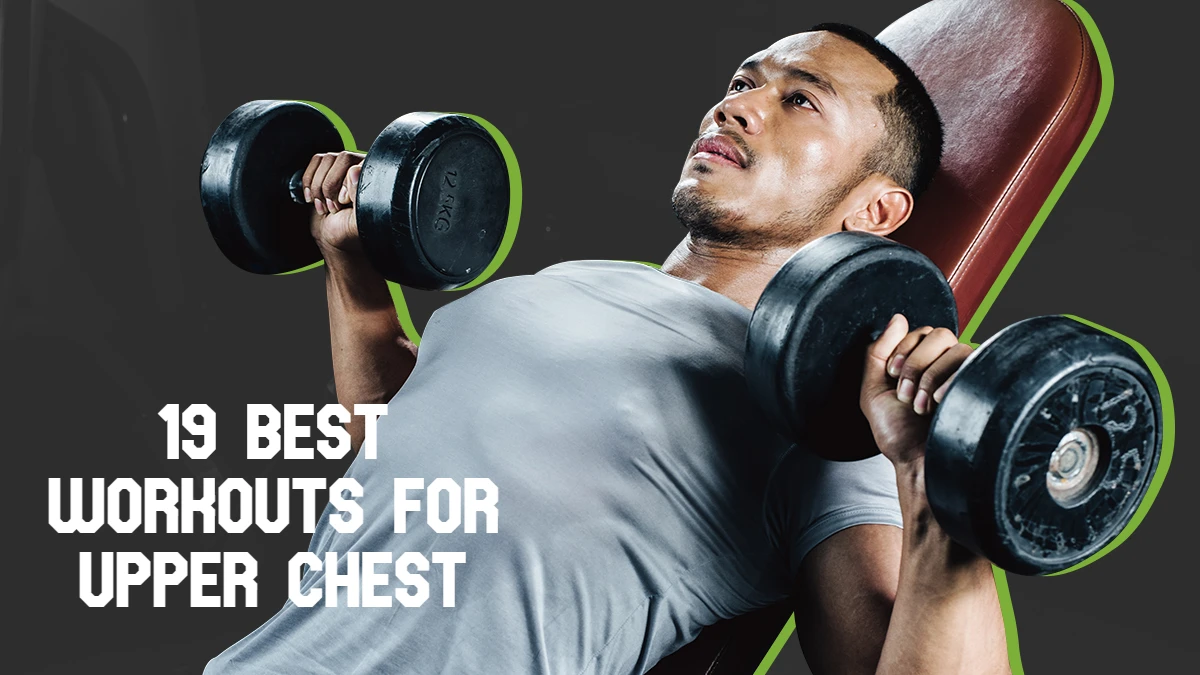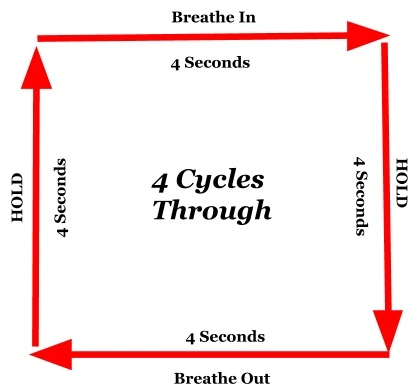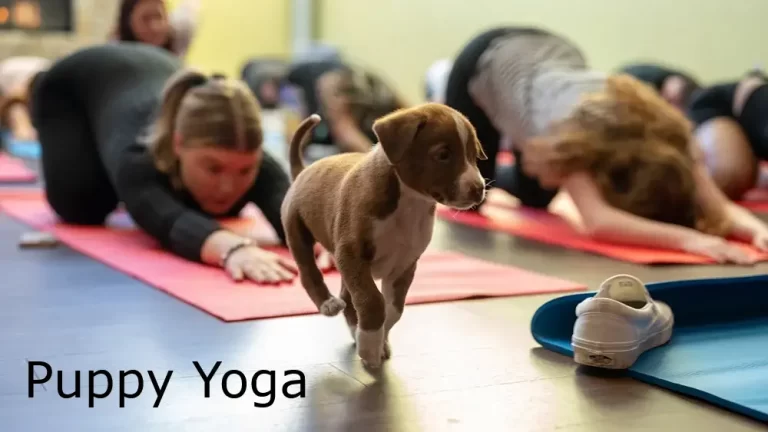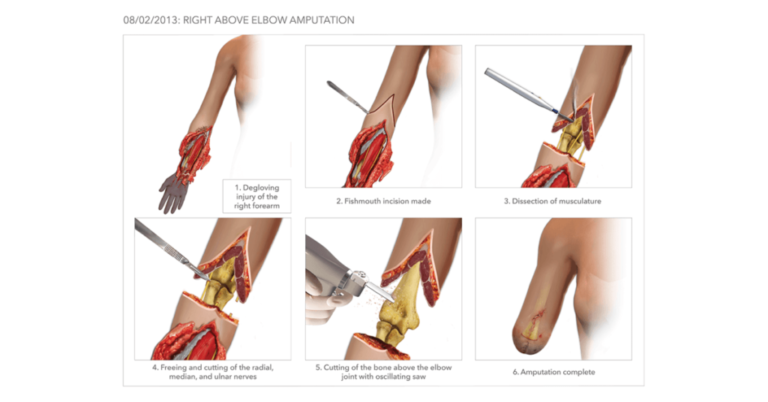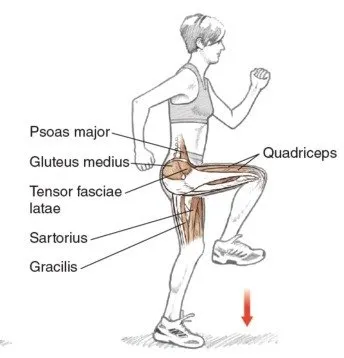19 Best Workouts for Upper Chest
Focusing on the upper chest is crucial for creating a balanced and visually appealing body. A robust upper chest enhances the overall development of the pectoral muscles and contributes to a fuller, more defined appearance.
Table of Contents
Upper Chest Muscle Anatomy
Because of the anatomy and physiology of the upper chest, you must engage in specific activities designed to activate it.
To help you understand how to activate each muscle to get the optimum reaction from your training, let’s take a quick look at the three chest muscles and what they do.
Pectoralis Major: The biggest and most noticeable muscle in the chest, the fan-shaped pectoralis major, is sometimes referred to as the “pecs.”The clavicular head sometimes referred to as the upper chest, and the sternocostal head, also known as the lower chest, make up this muscle.
Pectoralis Minor: This triangle muscle is situated in the upper chest region, beneath the pec major. Numerous actions of the body’s rear are mediated by this muscle. You may stimulate the pec minor by performing exercises like decline presses and dips, which require you to lower your shoulder blades downward. However, it is hard to isolate this muscle precisely.
Serratus Anterior: This muscle, which is located on the top surfaces of the ribs, connects to the shoulder blades by wrapping over your upper rib cage. This muscle’s primary job is to extend your reach forward and raise your arms aloft while pulling your shoulder blades forward.
Do you wish to have a large, strong chest?
- Then, you must strengthen the muscular fibers in your upper, middle, and lower chest.
- Among the most noticeable muscles in your upper torso are those in your upper chest.
- These are the muscles that create a lifted, arrogant chest and hoist your shirt.
- I’ll outline the top 19 exercises for the upper chest in this post, along with suggestions for combining them into a program.
How to Work Your Upper Chest Muscles?
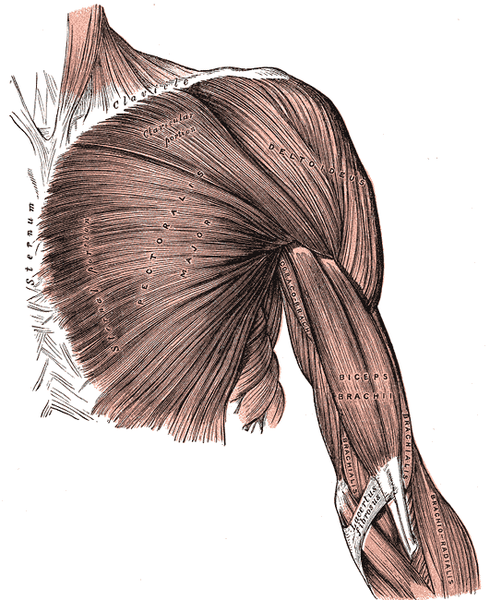
- Your chest muscles comprise one of the major muscular groups in your upper body.
- Your pectoralis major, or pecs, is the single, massive muscle that makes up nearly all of them on either side.
- Your pec minor, which is your pectoralis major’s little twin, is hidden behind it.
- The pectoralis major is a broad-rooting, voluminous muscle that resembles a fan.
- Usually, it is split into two sections:
- The bigger, lower piece is called the sternocostal component, and it comes mostly from your sternum (but it also partially originates from your ribs and upper abdominal sheath).
- Your lower and middle chest are seen here.
- The smaller, higher piece that starts at the first half of your clavicle is known as the clavicular part.
- This is our typical definition of the upper chest.
- A single tendon that inserts on the front of your upper arms is made up of muscle fibers from this entire range.
- Different pectoral muscle fibers will contract more or less depending on the angle at which you pull your arm forward.
- Your clavicular head will be the focus of incline pressing.
- The sternal head, or lower chest muscular fibers, are the focus of decline pressing.
- Similar to bench pressing, flat pressing will work your whole chest muscle, including the clavicular and sternal regions.
- When it comes to exercising your upper chest, you should perform exercises where you move your arm forward straight, which will work your chest muscles fairly evenly, or you can move your arm forward at a slight angle, which will highlight the fibers in your upper chest.
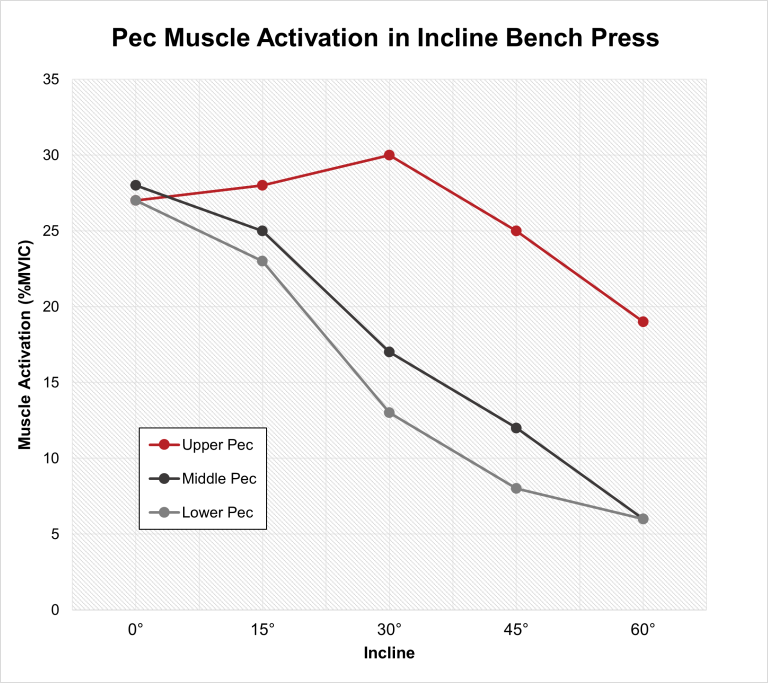
19 Best Upper Chest Exercises
Let’s examine 19 excellent exercises that focus on the upper chest as well as how to create an upper chest workout.
Incline Bench Press
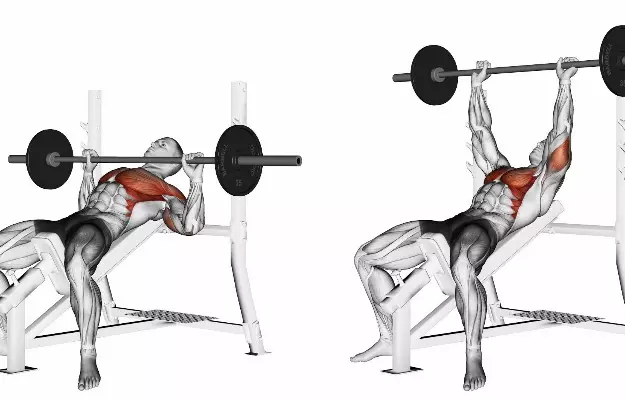
Steps To Follow
- Unrack a barbell while seated on an incline bench, then hold it above your shoulders with straight arms.
- Take a breath, then bring the bar down to your chest.
- Exhale as you press the bar up to straight arms.
Incline Dumbbell Press
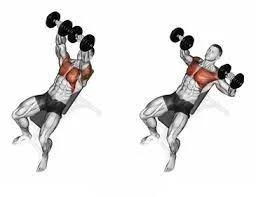
Steps To Follow
- Raise a pair of dumbbells to the beginning position while seated on a bench.
- Exhaling, raise the dumbbells to your arms in a straight position.
- At the peak, or as you carefully return the dumbbells down to your shoulders, take a breath.
Bench Press
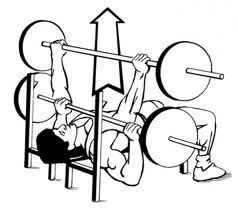
Steps To Follow
- While lying on the bench, slightly arch your back and draw your shoulder blades down.
- Slightly wider than shoulder-width apart, grasp the bar.
- Breathe in, hold it, then release the bar.
- Controllably lower the bar till it makes contact with your chest around your sternum.
- Breathe out as you raise the bar to the beginning position.
- Remain at the top position, take another breath, and repeat for the number of reps.
Close-Grip Bench Press
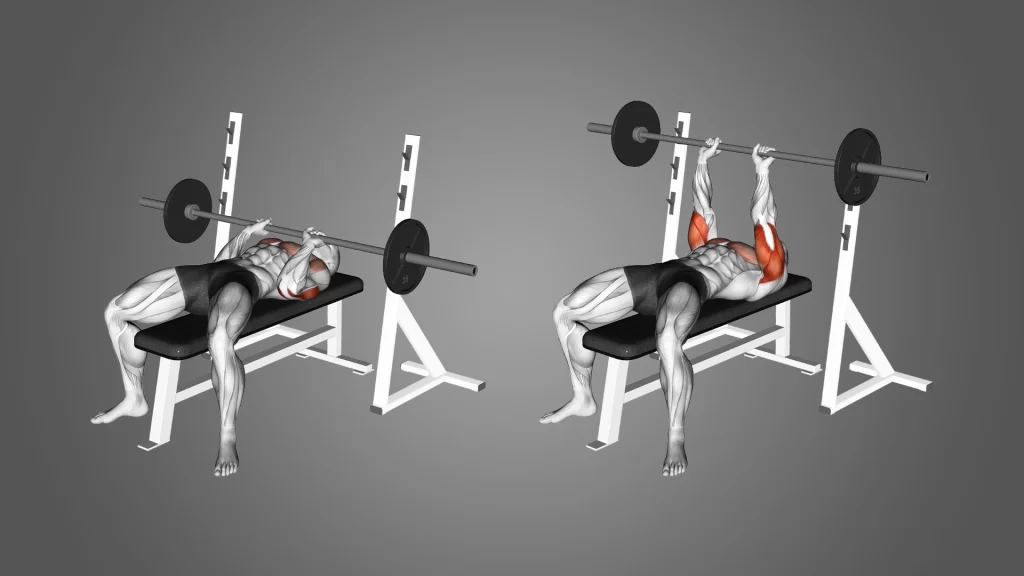
Steps To Follow
- While lying on the bench, slightly arch your back and draw your shoulder blades down.
- To ensure that your hands are directly or even slightly above your shoulders, grip the bar thinner than you would for a standard bench press.
- After taking a big breath and holding it, unscrew the bar.
- Carefully lower the bar until it makes contact with your chest at the point where your ribs stop.
- Breathe out as you raise the bar to the beginning position.
- Repeat for repetitions while taking another breath in the elevated posture.
Overhead Press
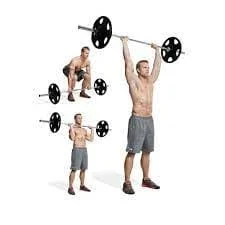
Steps To Follow
- Slightly wider than shoulder-width apart, grasp the bar.
- Breathe in, brace your core softly, and release the grip.
- Step back from the rack and let the bar rest against your front delts.
- Breathe out as you press the bar up to straight arms.
- At the peak, or as you carefully drop the bar down to your shoulders, take a breath.
Low to High Cable Chest Fly
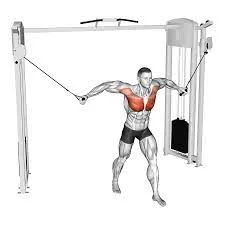
Steps To Follow
- Secure two handles of a cable cross at a low position.
- Take a step forward, grab the handles, and slant slightly forward.
- Push the handles forward until they touch in front of your chest, bending your arms just a little bit.
- Return the handles to their initial positions while maintaining control.
Dumbbell Chest Fly
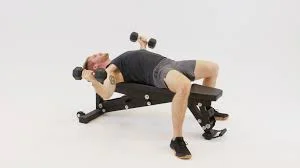
Steps To Follow
- Raise a pair of dumbbells to the beginning position while lying on a bench.
- Lower the dumbbells to your sides while maintaining a virtually straight-arm posture.
- After lowering the dumbbells as far as you can, spin around and raise them back up to the starting position.
Machine Chest Fly
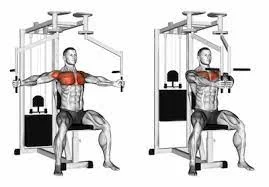
Steps To Follow
- To achieve a long range of motion and be able to grab the handles at shoulder height, adjust the back support and handles.
- Push the handles forward until they touch in front of your torso, bending your arms just a little bit.
- Return the handles to their initial positions while maintaining control.
Dumbbell Front Raise
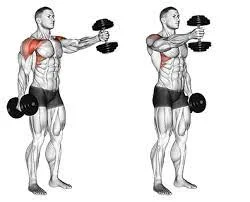
Steps To Follow
- Straighten your arms and hold a pair of dumbbells in front of your hips.
- Straight arms should be used to carefully raise the dumbbells forward until they are shoulder height.
- With control, reverse the motion and descend the dumbbells.
Decline Push-Up
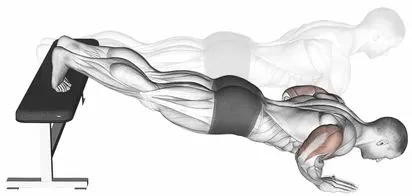
Steps To Follow
- With your hands on the floor and your feet resting on a low bench or box, take the first posture.
- Hold your hands slightly wider than the breadth of your shoulders.
- Brace your abdomen slightly and try to make a straight line from your head to your feet.
- Breathe in and descend as far as you can.
- Exhale as you turn the action around and push yourself up to straight arms once again.
Reverse Grip Dumbbell Press
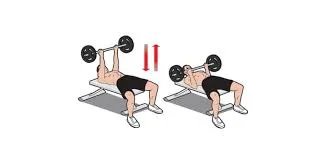
Steps To Follow
- Place a bench at a 30- to 45-degree inclination.
- Take hold of the dumbbells and settle into a bench posture.
- Start with your palms facing you and the dumbbells at a 45-degree angle with the handles to the side of your mid-chest.
- As soon as your arms are completely extended, press up straight.
- Reduce gradually to the beginning point.
- Continue until you reach the required number of reps.
Incline Dumbbell Around The World
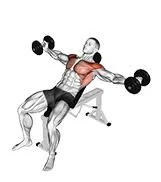
Steps To Follow
- Place a bench with an inclination of between 30 and 45 degrees.
- Take hold of the dumbbells and settle into a bench posture.
- Start by placing the dumbbells on your upper thighs with your hands facing up.
- Rotate your wrists as you raise the dumbbells to your sides.
- As you sweep in a circular motion, maintain your arms straight until your hands are over your head, in line with your torso, and your wrists have rotated 180 degrees.
- Return to your starting position by slowly reversing the same motion.
- Continue until you reach the required number of reps.
Cable Upper Chest Crossover

Steps To Follow
- Arrange the D-handles at the hip level.
- Place yourself in the center of the cable machine and use a neutral grip to hold both handles.
- Put yourself in a stumbling position and extend your arms to your sides.
- Bring your arms together by contracting your chest; initially, bend your elbows slightly.
- Then, move your arms upward until they meet in the middle, slightly over your head.
- Return to the starting position gradually.
- Continue until you reach the required number of reps.
Dumbbell Incline Flys With Wrist Twist
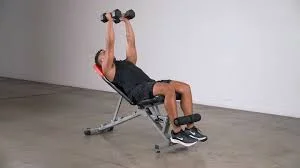
Steps To Follow
- The bench may be tilted from 30 to 45 degrees.
- With a neutral grip, pick up the dumbbells and take a seat on the bench.
- Dumbbells should be placed across your chest at first, with your elbows slightly bent.
- Dumbbells should be lowered gradually to your sides until the weights are shoulder height.
- To raise your arms up to the beginning position, contract your chest.
- As your arms approach the starting position, squeeze at the peak of the movement by twisting your wrists inside so that your palms are facing you.
- Continue until you reach the required number of reps.
Low To High Cable Flys
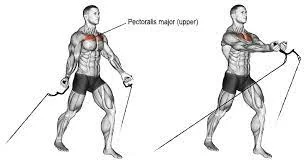
Steps To Follow
- Set the D-handles of the cable machine to the lowest position.
- Place yourself in the center of the cable machine and use both hands to grasp the grips with an underhanded grip.
- Step forward such that there is a strain on the wires while maintaining a staggered posture and keeping your hands at your sides.
- Lift the wires up and in front of your body while maintaining a straight back and an engaged core.
- Your arms should be slightly bent at the elbows.
- Squeeze your chest when your hands come together at the highest point of the movement.
- Reduce gradually to the beginning point.
- Continue until you reach the required number of reps.
Landmine Kneeling Squeeze Press
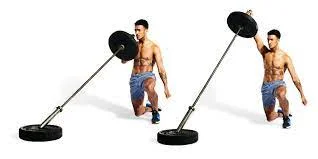
Steps To Follow
- Install a landmine bar.
- Get on your knees and clasp your hands together to grasp the bar with both hands in a neutral hold.
- Raise the bar so that your elbows are in front of your chest.
- When your arms are completely extended, press up and away while maintaining a straight back and an engaged core.
- Return to the starting position gradually.
- Continue until you reach the required number of reps.
Dumbbell Pullover
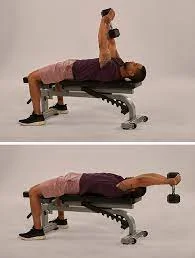
Steps To Follow
- Orient your body such that your upper back is perpendicular to a flat bench.
- Your head will be hanging over the edge of the seat.
- Step onto the ground with your feet hip-width apart.
- You’ll have somewhat smaller hips than shoulders.
- Hold the dumbbell with your hands in a diamond shape and the weight on your palms.
- With the dumbbell positioned exactly over your chest at first, and your elbows slightly bent, gradually lower it over your head until your arms are in line with your torso.
- Return the dumbbell to its initial position while focusing on the contraction of the chest.
- Continue until you reach the required number of reps.
Resistance Band Pushup
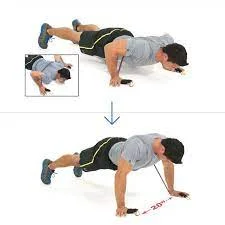
Steps To Follow
- Loop the band around your hands and then around your back and under your arms.
- Assume your stance with the band fixed beneath your hands and your hands somewhat wider than shoulder-width apart.
- Lower your chest toward the floor while maintaining a straight body until it is only a few inches above the ground.
- Contracting your chest will help you press up until your arms are completely extended.
- Continue until you reach the required number of reps.
Pink Pushup
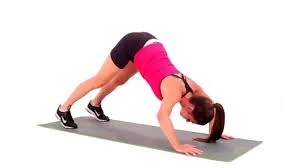
Steps To Follow
- Establish a stable platform (bench or chair).
- With your back to the raised surface and your feet resting on it, walk with your body bent and your hands extended.
- Lower your chest progressively until it is only a few inches above the ground while bending at the elbows.
- Contracting your shoulder, triceps, and chest will help you press up until your arms are completely extended.
- Continue until you reach the required number of reps.
Upper Chest Training Variables
There are specific training factors that will assist you in getting optimal outcomes when doing the workouts we have just gone over.
There are three key training factors for upper chest growth to take into account:
- Pressing Angle
- Grip Width
- Sets, Reps, & Loads
Let’s dig into each in more detail.
Pressing Angle
The impact of varying angles on muscle activation during the bench press was investigated in two distinct experiments. Here is a quick summary of the outcomes:
Upper Chest Activation Study:
- The Incline Bench (30°) resulted in optimal activation of the upper chest.
- Flat Bench activated mid-lower chest.
- 60-Grade Slope The anterior deltoid was maximally activated by the bench.
Bench Press Study:
- The upper and lower chest were efficiently stimulated with the Flat Bench.
- At particular moments throughout the action, an incline (30–45°) increased upper chest activation.
Key Takeaway: Aim for an angle of 30-45 degrees when performing pressing exercises to increase stimulation of the upper chest. Employing an inclination angle higher than 50 degrees will cause you to emphasize your front delts more than your upper chest.
Grip Width
When performing a bench press, the way your hands are positioned on the bar will determine which muscles are used. When performing the bench press, make sure you employ a shoulder-width grip to engage your upper chest more. By using a broader grasp, you may shift the strain from your upper chest and shoulders to your mid-chest.
Sets, Reps & Load
About 60% of the muscle fibers in the chest are fast-twitch, and 40% are slow-twitch. This implies that you should use a range of rep ranges and weights while exercising the upper chest. Remember your ultimate objectives and the following broad rep range guidelines:
- Power: 1-3 reps
- Strength: 4-6 reps
- Hypertrophy: 6-12 reps
- Endurance: 12+ reps
Best Workout For Upper Chest With Weights
- We’ve put up an intense upper chest exercise that will blow your mind.
- Recall to alternate between sets and reps every one to two mesocycles.
- Try to work out like this once a week.
A good upper chest workout with weights is:
- Incline Bench Press: 3 sets x 6-8 reps
- Low To High Cable Fly: 3 sets x 12-15 reps
- Reverse Dumbell Chest Press: 3 sets x 8-12 reps
- Three sets of AMRAP decline push-ups (as many repetitions as feasible)
Notes for performing this upper chest workout:
- 1.5-2 minute rests between sets.
- 2-3 minutes of dynamic chest stretches before the workout, plus warmup sets as needed (see chest stretches below).
- 2-3 minutes of static chest stretch after workout.
Best Upper Chest Workout At Home
This is the ideal at-home exercise program for your upper chest:
- Decline Push Ups: 4 sets x 12-20 reps
- Pikes Push-Ups: 4 sets of 8–10 repetitions
- Banded Push-Ups: 4 sets x 6–8 repetitions (almost to failure)
Notes on performing this at-home upper chest workout:
- 1-2 minute rest between sets.
- 2-3 minute dynamic chest stretches before a workout.
- 2-3 minute static chest stretches after workout.
Upper Chest Stretches
These are two easy stretches that can help you stretch your upper chest.
Static stretches are best done after a workout, while dynamic stretches are best done before any upper chest exercises.
Warm Up: Dynamic Chest Opener
Warm up your pecs with dynamic stretches like this one and a few warmup sets with modest weights before beginning any upper chest workouts or routines. You may perform this easy chest opening before starting your initial warm-up sets.
Steps To Follow
- Stand up straight
- Raise your arms to your chest and place your palms together in front of you.
- Open your arms to your sides as far back as you can, then return to the starting position
- Repeat three sets of 10-20 reps
Cool Down: Static Chest Stretch
After working out your upper chest, stretch your chest statically to release tension in your pecs.
Stretches like this one, which are static in nature, may help hasten the healing process following a strenuous workout.
Steps To Follow
- Stand up straight with your hands to your sides and your feet hip-width apart
- With your elbows extended and your thumbs pointing down, place your palms on your hips.
- To stretch your pecs, lean back, elevate your chest, and push back through your elbows.
- Hold for 10-20 seconds
- Repeat 2-3 times
Tips For Upper Chest Workouts
Focus on Angle & Variety:
- When performing exercises like the bench press, dumbbell press, or flys, set an incline bench at a 30 to 50-degree angle.
- Perform low-to-high cable fly if you’re using a cable machine.
- Use a range of exercises using various tools, including cables, dumbbells, and barbells.
- You can perform more machine isolation exercises during one session and higher free weights during the other if you work on your chest twice a week in a PPL program or upper/lower split.
- Make use of a range of sets, repetitions, and weights, such as heavier loads with lower reps and lighter loads with greater reps.
- Select workouts that align with the upper chest’s fiber angle.
Weekly Volume Is Crucial:
- Avoid overtraining. Aim for one or two weekly bouts of chest training.
- Make use of a range of sets, repetitions, and weights, such as heavier loads with lower reps and lighter loads with greater reps.
- Aim for 12–20 chest workout sets each week.
Use A Wide Variety of Training Strategies:
- Try utilizing a variety of training techniques, such as supersets, drop sets, and rest-pause sets.
- Elevated pushups: Place your feet on an elevated platform that is the same 30 to 50 degrees to maintain a strong upper chest without the need for any equipment.
- Start with the chest at the beginning of your exercise when your muscles are fresh if you’re on a push/pull/leg split.
Benefits Of Training Upper Chest
In addition to better-defined pecs, there are numerous more advantages to training your upper chest. The following are the top advantages of engaging in upper chest exercises:
Improved Functionality: Numerous daily tasks need motions that are directly controlled by the upper chest. Maintaining a robust and flexible chest enables you to function more effectively in daily life.
Look Better: Exercises for the upper chest will help your chest appear fuller. It’s critical to have a stable chest posture. For both men and women, building up the clavicular head or upper chest will improve your appearance both in and out of clothes. Strong pecs support the stabilization of the shoulder joint, which helps to enhance posture.
Enhance Pressing Power: Increasing the number of upper chest exercises in your training regimen can help you move bigger loads while pressing or pushing. You’ll be able to lift more weights during an overhead press exercise in addition to increasing your bench press strength. Increasing your pressing strength capacity will help you perform better in sports and get ready to carry out everyday tasks with ease. It can even expand your upper arms since you’re hitting your tris.
Breathe Easier: Since the pecs are connected to the ribs, respiration may be improved by exercising and strengthening them.
Conclusion
Among the most noticeable muscles in your upper torso, your upper chest muscles are responsible for raising and extending your upper arms. Exercises that work your entire chest, like the bench press, or just the upper chest, like the incline bench press, are two ways to train your upper chest.
To build muscle in your chest and strengthen your upper body, one effective strategy is to simply get stronger at the bench press. Check out our programs for bench press if you want to get better at it.
FAQ
Either poor form on the bench press or insufficient nourishment is probably the cause of the lack of development in the upper chest. A poorly performed bench press prevents the chest from being properly activated, which stops the creation of new muscle. For the best possible upper chest development, proper form is essential.
Since the fibers in the upper chest are attached to the clavicle, or collarbone, activating them might be difficult. Conventional pressing workouts focus mostly on the middle and lower chest, frequently ignoring the upper chest. Exercises like the incline bench press and low-to-high cable fly are great for building your upper chest. When you first start working out and have the most energy, perform upper chest exercises.
Since the muscles in the upper chest and shoulders are so intimately related and cooperate when pushing, it is impossible to fully separate them. The greatest thing you can do is employ proper technique and a weight load that will allow you to fully exhaust your upper pecs, not just your anterior deltoids while concentrating on mind-muscle connection.
Although one exercise that targets the upper chest particularly might be helpful, it is usually more useful to incorporate a number of exercises in order to effectively build and strengthen the muscles of the upper chest. If you only do one exercise, your upper chest’s potential for development and general stimulation may be limited. Try to incorporate at least two upper chest exercises into your weekly routine. If your upper chest isn’t working as much as it should, start your workouts with such exercises.
It takes a mix of focused workouts, a healthy diet, and regular exercise to get a toned upper chest. To acquire that toned upper chest appearance, it really just boils down to lowering your body fat % after you have the muscle massed.
References
- Richter, D. (2023, May 23). The 10 Best Upper Chest Exercises for Powerful Pecs. StrengthLog. https://www.strengthlog.com/upper-chest-exercises/
- Set, S. F. (2023, December 22). 12 Best Upper Chest Exercises To Fill Out Your Pecs. SET FOR SET. https://www.setforset.com/blogs/news/upper-chest-exercises
- George, R. (2023, November 6). 8 Best Upper Chest Exercises For A Stronger, Defined Chest. Workout Planner. https://fitnessprogramer.com/8-best-upper-chest-exercises/

